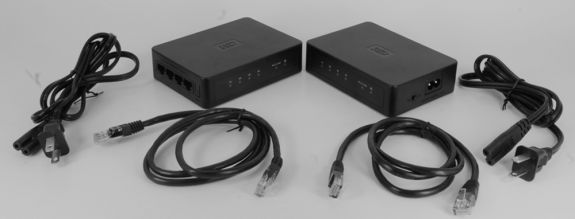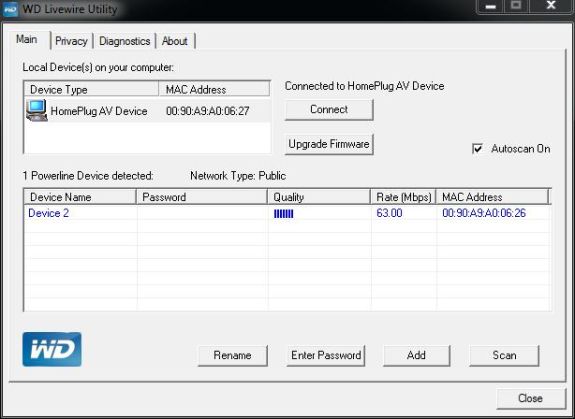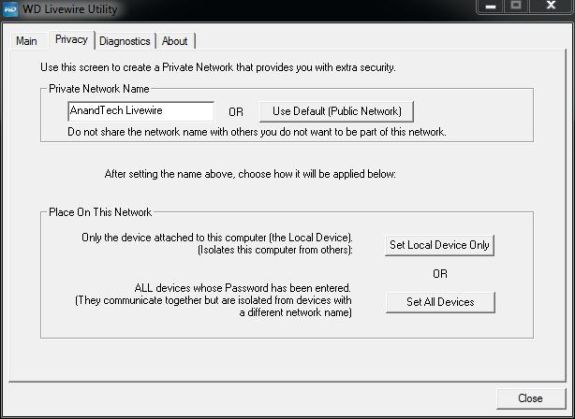Powerline Networking with the Western Digital Livewire
by Ganesh T S on August 24, 2010 7:50 AM EST- Posted in
- Gadgets
- Networking
- Powerline Adapters
The WD Livewire comes in a box with the bare essentials. Unlike the WDTV Live, there aren't as many cables or batteries to deal with. Opening the package reveals a pictorial setup guide, the warranty document and the setup CD. Beneath this, we have a pair of powerline kits. Each kit consists of a 4 port routing unit, along with a short Ethernet cable and an AC power outlet connector. The routing unit is made of black plastic with a WD logo on the top side. It blends well in any sort of setup, and is quite similar in structure to the WDTV Live, except that it is not as thick. This can be seen quite clearly in the photograph below.

Setup CD / Documentation not shown
Setup is very straightforward, even for the non-technical folks. One port of the routing unit is connected to the main router's outlet ports. The other ports in the routing unit (there are 4 ports on each) can be used as an extender for the main router, thereby acting as a port multiplier. This will not be ideal of the router is Gigabit in nature, as all the outlet ports of the routing units in the powerline kits are only Fast Ethernet (100 Mbps). This routing unit is connected to the power outlet. We are not aware of any other powerline adapter kit which can also be used as a port multiplier at the source point (on the main router side).
The other routing unit can be connected to any power outlet in the residence, making available 4 Ethernet ports at that power outlet for usage. It is not hard to imagine requiring four ports at the second power outlet, particularly if it is the entertainment center. A large number of TVs, Blu-Ray players (and the WDTV Live, as well) and other entertainment center components come with an Ethernet port for connecting to the Internet as well as the home network. The package goes to great lengths (to the extent of placing stickers to cover up the power outlet plug point on the routing unit) to make sure that users don't connect it to a power strip or surge protector. This is an advice provided with good intentions, as we personally saw some of the low cost surge protectors halving the available bandwidth. This will be covered in detail in the benchmarking section.
It is not essential to run the installation CD, as we were able to get up and running without it. However, for people who want to secure their powerline network, the installation CD comes with a Livewire utility. As can be seen from the screenshots below, the utility allows firmware updating, and also indicates the powerline kits available on the network (other than the primary one connected to the router). We also get an indication of the bandwidth available on that particular device.
The Privacy tab allows the user to setup a name for the Powerline network, and gives an option to only allow devices on which the password has been entered. The entering of the password referred to in the screenshot actually implies the pressing of the 'Sync' button on all the powerline kits which are intended to become part of the private network. This has to be done for less than 3 seconds on each, but not more than 2 minutes apart.
WD also supplies a 26 page PDF manual with detailed setup and troubleshooting details. All said, the packaging of the kits is professional, and setup is quite straightforward for even the novice users. Most people should get up and running in no time, provided they do not need to mess with private networks of any kind.












31 Comments
View All Comments
jkostans - Tuesday, August 24, 2010 - link
Ethernet is not twisted to prevent radiation, it's to reduce noise in a differential transmission line. (The fact that ethernet signaling is differential reduces radiation and loss but not the twists) In theory by keeping the wires as close as possible any noise that influences one wire will equally influence the other wire in the same manner. When the subtraction is done to find the voltage, the net result of the noise will have no effect. It's like the equation (5+X) - (0+X) = 5. No matter what value of the noise (X) is, the equation will always equal 5.chromatix - Tuesday, August 24, 2010 - link
The twists have both effects, and effectively isolate the electromagnetic fields of the wires and their surroundings up to a certain frequency and down to a certain distance. It is the isolation which eliminates both emissions and received noise.flgt - Tuesday, August 24, 2010 - link
I think to some extent you're both right. The reduction in emissions comes from the fact that the signal is driven differentially (equal amplitude, opposite polarity) and the control of the electric fields which are generated. In a non-perfect transmission line there is a finite amount of cancellation between the two fields which can be improved with cable construction (Cat 6 > Cat 5 >> Romex). Twisting improves performance but a shield is required optimal emission performance. However the increased costs and installation time of shielded cables make them a less desirable solution as long as regulatory requirements can be met.As stated, differential signaling provides inherent common-mode noise immunity which is aided by the tight coupling of the twisted wires. The twisting helps ensure the radiated noise excites each conductor in the pair equally (again to some finite amount).
I don’t see this being a major issue for radio operators for a number of reasons:
1) The noise immunity provided by differential signaling allows the line to be driven at lower voltage levels, thereby further reducing emissions.
2) The use of OFDM allows each individual frequency channel to be operated at very low signal-to-noise ratios due to the low-order modulation scheme being used. This is the only way they can operate over such a horrible channel in the first place (your power line). They most likely operate each carrier at a very low signal level to make the composite spectrum look more like broadband noise. DSL essentially operates in the same way.
3) The signal will quickly attenuate since the channel is so bad.
Per Hansson - Wednesday, August 25, 2010 - link
I can confirm your suspicionsI recently bought the Belkin Gigabit Powerline HD networking kit
It managed to do 5Mbps over my powerlines, an apartement built 1990
When I turned on my FM radio there was an amazing ammount of noise in the reception when I was transmitting data, less so when I was not transmitting data but still some pops and cracks in the reception
When I unplugged the adapter the reception became perfect
Next test was to run the powerline adapter from the apartement out in to my garage, the speed now dropped to 1Mbps
To my suprise though it managed to even interfere with the FM reception in my car!
The signal got way harder to recieve, it did not crack and pop in the audio tho, but I think that may be simply due to the fact that the stereo in my car is much better at receiving a signal, and the fact that the car itself acts like a faraday cage...
To say the least I returned this "Gigabit" junk
yottabit - Tuesday, August 24, 2010 - link
There's a typo in the second sentence of the summary article on the anandtech home page... :(reckert - Tuesday, August 24, 2010 - link
In most homes, the electric coming in is 240v, and the circuits are split to 2 sets of 120v. I know from past experience power line protocols such as x10 couln't get their signals to jump between the two sides of the wiring without a special bridge.ganeshts - Tuesday, August 24, 2010 - link
reckert, as you mention, x10 needed something to plug in to bridge the legs of the circuits. However, as all Homeplug stuff is on high frequency, they bridge due to the capacitive effect of the bus bars in the circuit breakers. Therefore, you will not have a problem with the configuration you mention as long as you are using HomePlug certified devices.Souka - Tuesday, August 24, 2010 - link
My house build 1984...2 story, 2200 sq/ftCable modem on second floor, tv on 1st with BriteView media player.
Netgear XE-104 (up to 85Mbs claim)... on same curcuit directly plugged into wall I got barely 15Mbps. Different circuit in adjoining rooms 5Mbps. Different circuit on different floors...under 1Mbps and often dropped connection.
BELKIN F5D4073 (up to 85Mbps) Powerline Turbo similar results...
Also tried the kits in my parents 1960's 2 story 3500 sq'ft home....worse results...
I really like the idea of powerline tech, just doesn't deliver for me
ganeshts - Tuesday, August 24, 2010 - link
Souka,Please take a look at the SmallNetBuilder guide here, as it may be of some help to you: http://www.smallnetbuilder.com/lanwan/lanwan-basic...
It is best to buy these type of products from stores which have a good return policy / no restocking fee. Unless the consumer actually tries it out, it is not possible to know in advance as to how well the technology would work, as is evident in your case.
Souka - Tuesday, August 24, 2010 - link
I might give the XAVB5501 or XAVB5001 a shot when they come out....none of the listed retailers (or froogle.com) came up with any units available.I do wish they had dual ports... or at least in kits one of the units had dual ethernet ports.
Yes I can easily hook a switch to it, but rather not.